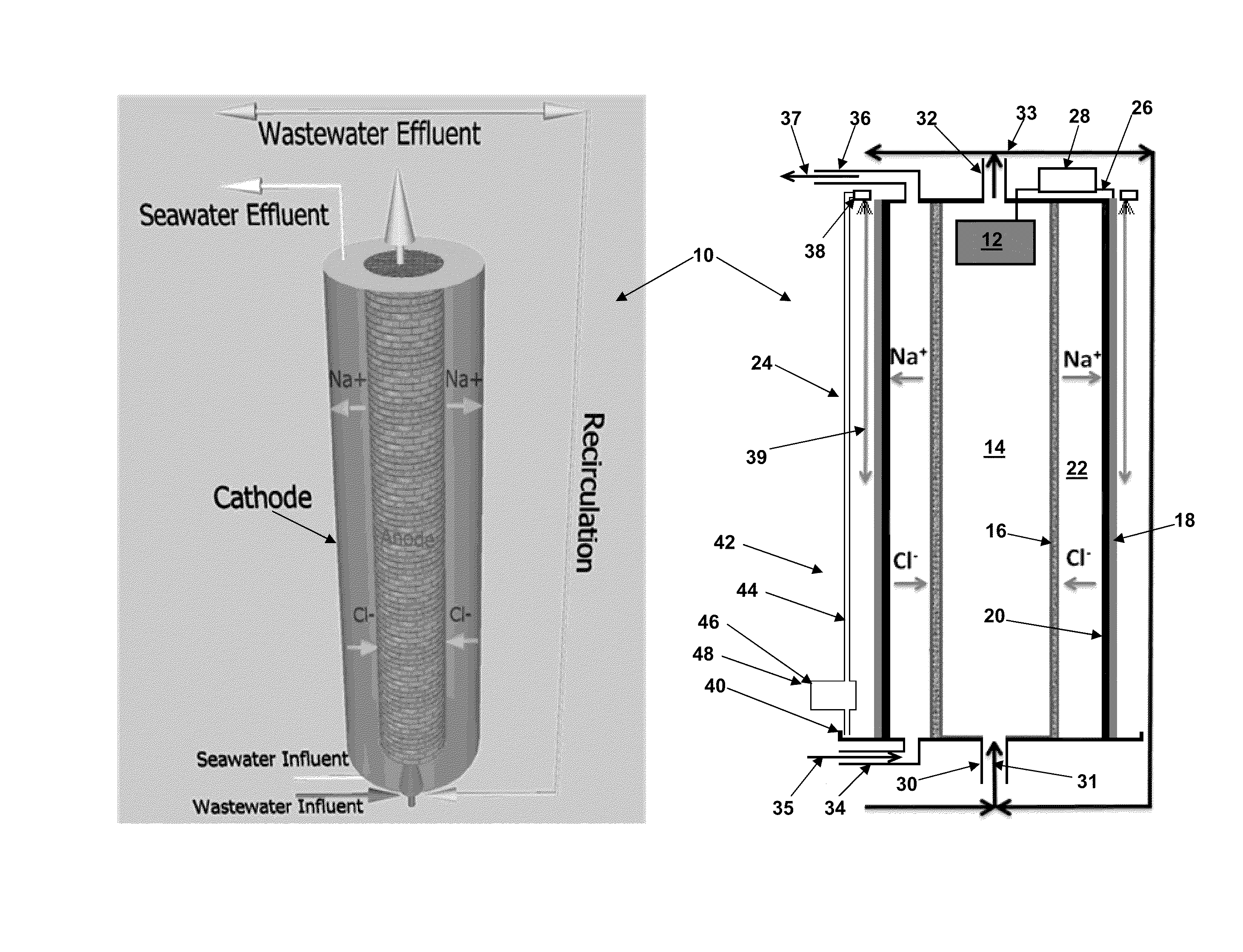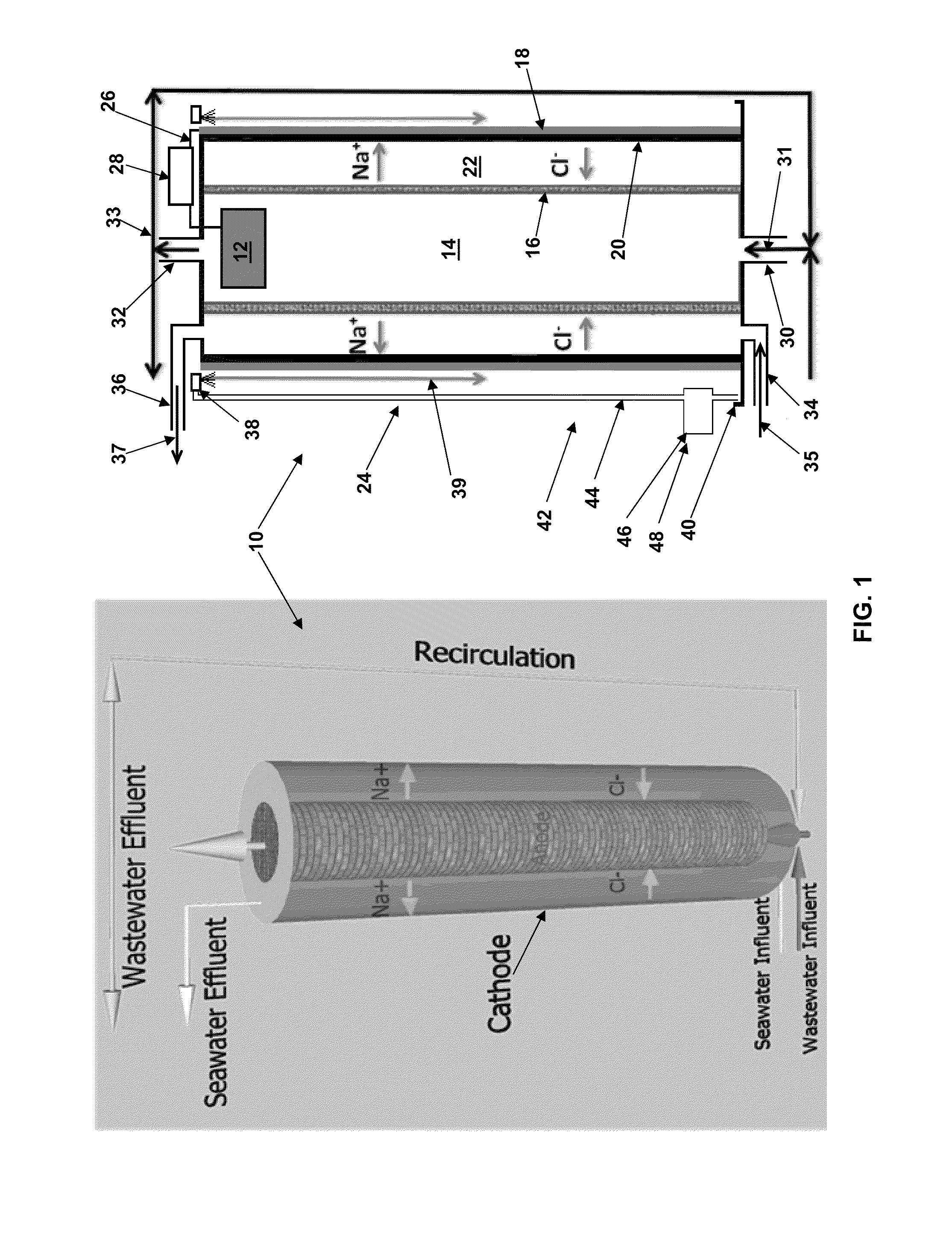Microbial desalination cells
a desalination cell and microorganism technology, applied in the direction of filtration separation, other chemical processes, separation processes, etc., can solve the problems of inability to use agricultural irrigation, lack of adequate fresh water, and inability to meet the needs of agricultural irrigation, etc., and achieve the effect of improving the quality of desalination
- Summary
- Abstract
- Description
- Claims
- Application Information
AI Technical Summary
Benefits of technology
Problems solved by technology
Method used
Image
Examples
example 1
MDC Setup
[0064]Two cylindrical MDCs were provided having the general construction shown in FIG. 1. Each MDC 10 included an anode 12, an anode chamber 14, an anion exchange material 16, a cathode 18, a cation exchange material 20 and a saline solution chamber 22. For each of the MDCs, the anion exchange material (AMI-7001, Membrane International Inc., Glen Rock, N.J., USA) had a tubular or cylindrical shape that defined the cylindrical anode chamber and the inner wall of the saline solution chamber. Each cation exchange material (CMI-7000, Membrane International Inc.) surrounded the anion exchange material and had a tubular or cylindrical shape that defined the outer wall of the saline solution chamber. The membrane tubes were sealed using epoxy. The anode chamber included an inlet 30 at the bottom of the anode chamber and an outlet 32 at the top of the anode chamber. Similarly, the saline solution chamber included an inlet 34 at the bottom of the saline solution chamber and an outle...
example 2
Operating Conditions for the First MDC
[0067]The first MDC was operated for more than four months, and it consistently removed salts while generating electricity.
[0068]Synthetic wastewater was prepared by dissolving sodium acetate (4 g / L), NH4Cl (0.15 g / L), NaCl (0.5 g / L), MgSO4 (0.015 g / L), CaCl2 (0.02 g / L), KH2PO4 (0.53 g / L), K2HPO4 (1.07 g / L), yeast extract (0.1 g / L), and trace element (1 mL / L) into tap water. The synthetic wastewater was fed as influent 31 though the anode chamber inlet 30 and into the bottom of anode chamber 14 at a flow rate of about 0.7 mL / min. Effluent 33 was discharged from the top of the anode chamber through the anode chamber outlet 32. The effluent from the anode chamber was recirculated at about 120 mL / min and its HRT was about 12 h. The anode 12 was inoculated with a mixture of aerobic and anaerobic sludge from local wastewater treatment plants (Jones Island Wastewater Treatment Plant and South Shore Wastewater Treatment Plant, Milwaukee, Wis., USA). Th...
example 3
Operating Conditions for the Second MDC
[0073]The second MDC was operated for periods of more than eight months, and it consistently removed salts while generating electricity.
[0074]Synthetic wastewater was prepared by dissolving sodium acetate (3 g / L), NH4Cl (0.15 g / L), NaCl (0.5 g / L), MgSO4 (0.015 g / L), CaCl2 (0.02 g / L), KH2PO4 (0.53 g / L), K2HPO4 (1.07 g / L), yeast extract (0.1 g / L), and trace element (1 mL / L) into tap water. The synthetic wastewater was fed as influent 31 though the anode chamber inlet 30 and into the bottom of the anode chamber 14 at a flow rate of about 4.0 mL / min. Effluent 33 was discharged from the top of the anode chamber through the anode chamber outlet 32. Effluent from the anode chamber was recirculated at about 200 mL / min and its HRT was about 8 h. The anode 12 was inoculated with a mixture of aerobic and anaerobic sludge from local wastewater treatment plants (Jones Island Wastewater Treatment Plant and South Shore Wastewater Treatment Plant, Milwaukee, W...
PUM
| Property | Measurement | Unit |
|---|---|---|
| hydraulic retention time | aaaaa | aaaaa |
| temperatures | aaaaa | aaaaa |
| temperatures | aaaaa | aaaaa |
Abstract
Description
Claims
Application Information
 Login to View More
Login to View More - R&D
- Intellectual Property
- Life Sciences
- Materials
- Tech Scout
- Unparalleled Data Quality
- Higher Quality Content
- 60% Fewer Hallucinations
Browse by: Latest US Patents, China's latest patents, Technical Efficacy Thesaurus, Application Domain, Technology Topic, Popular Technical Reports.
© 2025 PatSnap. All rights reserved.Legal|Privacy policy|Modern Slavery Act Transparency Statement|Sitemap|About US| Contact US: help@patsnap.com



